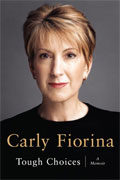Like all timely memoirs of recent disasters, Carly Fiorina’s Tough Choices will be read first at light speed, as interested parties skim through to find the account of her final days as Hewlett-Packard CEO and her take on the board members who unceremoniously fired her last year. (To see Knowledge at Wharton’s interview with Carly Fiorina, conducted earlier this week, click here.)
A quick read will uncover an eyeful, including her cutting portraits of figures like board member Jay Keyworth (“emotional”), Compaq CEO Michael Capellas (“rude and abusive”), and board member Walter Hewlett (easily manipulated), as well as her conviction that her leadership of HP was a success.
But Tough Choices is more than a throw-away tell-all. After extracting the news-related nuggets, readers should put the book down and pick it up again as if they had never heard of Carly Fiorina. Her memoir is peppered with keen observations of the psychological workings of big corporations; more, it is a testament to a passionate love for the teamwork, vision and sheer hard work of business life. Unfortunately, Fiorina fails to use her insight to reconcile this near-triumphant account of her controversial tenure with the widespread belief that it was a disaster.
Fiorina’s background doesn’t suggest a career in corporate leadership. Her mother was an artist and her father an academic; she studied philosophy at Stanford, dropped out of law school and was rejected from the University of Maryland’s MBA program. (She talked her way back in.)
Starting out at the absolute lowest rung — as a Kelly girl — Fiorina embraced her first real job, answering phones at a brokerage firm just one block from HP headquarters, with pure joy: “I loved the pragmatic nature of the work. You did something and something happened,” she writes. “Most of all, I loved the people of business.”
This sense of excitement and devotion drives the first half of Fiorina’s story, as she joins AT&T after business school and rises through the ranks. The book delivers several well-paced business stories. One of the most absorbing begins with her feeling like a fifth wheel as the 30-year-old manager of a team of competent AT&T engineers. With divestiture unleashing chaotic forces in the organization, Fiorina looked for a problem to solve and began to review billing records. After discovering systematic overbilling, she lit a fire under headquarters until the problem was resolved, saving the company hundreds of millions of dollars. The anecdote demonstrates how mid-level leadership in a giant corporation can successfully effect change.
In her stories from AT&T and, later, Lucent, she draws out management lessons. Occasionally, her insights fall flat (“Trust was important to business,”) but for the most part she successfully weaves them through the narrative, giving life to what otherwise might be boring truisms.
Many of her best insights revolve around the central observation that “business is about people.” While at MIT’s Sloan school — where she earned an M.S. in business, sponsored by AT&T — she saw CEOs up close for the first time. “Just like people everywhere, some were good at their jobs; some weren’t,” she writes. “Some got to the top after a lifetime of preparation; others still seemed surprised they were there. Some practiced intimidation; some were engaging. Mostly the interactions took the mystery out of the CEO.”
This clear-eyed view was key to Fiorina’s understanding of herself; she realized that she, too, could be a CEO. Seeing complex, powerful institutions as aggregations of human beings also gave her the ability to break problems into component parts, which she could then tackle. When the intimidating head of AT&T’s Network Systems International was yelling and swearing at Fiorina for the many perceived wrongs of her team and the company, she responded with her own harsh and colorful words — and, she writes, won him over.
Fiorina’s focus on people results in an earthy wedding of psychology and business practice. As director of AT&T’s International Strategy and Business Development, she and her team agreed on a framework to focus on certain international markets and ignore others. “Intellectually, everyone understood that a framework for deciding how to allocate our resources made sense. Intellectually, people even understood that our win rates would improve. Yet it felt emotionally limiting,” she writes. Grasping the problem, Fiorina could decide on a solution: aiming to be the market leader so the excitement of competing would replace the fear of limitation. Grasping the problem, Fiorina decided on a solution: Aim to be the leader inevery market so the excitement of competing would replace the fear of limitation.
Similarly, Fiorina used her emotional intelligence when AT&T and Lucent representatives were mired down in discussions over Lucent’s prospectus, often reopening issues that had already been resolved. Asked for help by Lucent’s comptroller, Fiorina broke the process down into tangible parts: The group would read each page, and issues would either be decided on the spot or tabled for higher-ups to consider. After each page was completed, it was turned and could not be revisited. “The physical act of turning the page became a symbol of progress and a victory to be celebrated,” she writes.
The book’s emotional peak comes in Fiorina’s involvement in the successful creation of Lucent. She observes several times that it’s easier to create a new entity rather than reinvent the “left behind” company, and Lucent’s spin-off suited her taste for rapid change, intense teamwork and ambitious goals. She and fellow executives met with potential investors before going public in a road show that was “a mind numbing” three weeks of eight presentations a day. “And yet I loved every minute of it — the intense pleasure of the seamless team we had become, the thrill of doing something for the very first time, the excitement of talking about something I believed in so deeply, the knowledge that we were building a company right before our very eyes,” she writes. And of the moment in 1996 when a hot air balloon with the Lucent logo was released to symbolize the company’s independence from AT&T, she writes simply, “I loved Lucent.”
Wine, Women and Song
Driven by this enthusiasm, Fiorina is impatient with gender issues. Explaining her discomfort with being crowned the Most Powerful Woman in Business by Fortune in 1998, she writes, “I didn’t want to talk about being a woman in business. I wanted to talk about business.”
No one can accuse her of being squeamish about sexism. The book includes not only the well-known tale of her attending a business meeting at a Washington D.C. strip club (“I was cordial and tried to appear relaxed,”), but also a few jaw-dropping stories, as when the president of a Korean company gave her a female companion for a night of traditional drunken feasting and song (“I could see why men absolutely loved this style of entertaining,”) and when, as a Lucent executive, she tried to impress a cocky sales team by getting on stage with socks stuffed in her crotch to say, “Our balls are as big as anyone’s in this room.”
Fiorina was harassed, insulted and propositioned, mostly early on in her career, but from these experiences she culls some sound advice — you have 20 minutes to prove you know what you’re talking about — and even a bit of wisdom: “Life isn’t always fair, and it is different for women than for men.”
Ironically, it was not sexism that caused her to stumble, but rather the fame that her success as a woman created. For Fiorina, sexism was just one more challenge, one more complex psychological problem that she could solve. Celebrity was a nut she couldn’t crack. After appearing on the cover of Fortune, she writes, “Some people thought that as a celebrity, I was now different from them, separated from others. Many could no longer see me at all. They could only see ‘Carly Fiorina, the Most Powerful Woman in Business.'”
With all of her emotional intelligence, she was unable to extract herself from the trap of being a successful woman people love to hate (The New York Times’ Alessandra Stanley made the logical link to Hillary Clinton and Martha Stewart). As a result, a person who prided herself on asking questions and sparking debate before making decisions was now branded as cold and remote. “A leader must capture hearts as well as challenge minds,” she writes. But the book offers little insight into how she failed so dismally in capturing the necessary hearts in and around HP.
Wrong Fit?
In the second half of the book, when Fiorina joins HP, the vitality fades from her writing. Although she often mentions that what she loved best about HP was its people, we meet very few of them. In place of her lively, character-filled stories from AT&T and Lucent, Fiorina offers a grim, drawn-out assessment of HP as a company in thrall to its past success, with a risk-averse culture and an incoherent organizational structure to boot. She lectures about the need for change, making analogies with everything from evolution to bull-fighting, as if still trying to convince a skeptical audience; one can imagine the feeling of having change crammed down one’s throat.
What becomes most puzzling is why the board offered the job in the first place, and why Fiorina accepted it. The board needed someone who could effect major changes. But was bringing someone from sales into an engineering-based company, a straight-talking woman into a conflict-avoidant culture, really a strategic fit? If Fiorina is right that the board was dysfunctional, then perhaps their hiring of her was a symptom of that disorder.
On Fiorina’s side, she noticed some troublesome issues with the board before even singing on as CEO. During a pre-hiring meeting with board member Dick Hackborn, Fiorina criticized a reorganization that had created four new CEOs. Hackborn agreed with her on that issue and more, which prompted Fiorina to wonder, “How could a board member who agreed so enthusiastically with me have so passively permitted a major move like this to occur?”
Rather than see this episode as the warning light it was, Fiorina continued her talks with the board. Was she blinded by her own desire to reach the top leadership position? She shares an eerie story about her sense of destiny: Just before her mother passed away (some months before the HP job was on the table,) “she said with a faraway look in eyes, ‘Who knows. Maybe someday you’ll become the CEO of Hewlett-Packard.'” The comment raised the hairs on the back of Fiorina’s neck.
Why she accepted the job, and later, why she championed the Compaq deal, may have something to do with Fiorina’s dedication to the decision-making process. The recruitment dance with the board lasted more than six months and involved many detailed discussions. She told her father she didn’t want to “sell” the board on her: “The board couldn’t get buyer’s remorse halfway through the journey. They needed to buy into me as the CEO all the way, and that required them to understand in every possible dimension what a controversial and risky choice I would be.” Fiorina may have given the board more credit for due diligence than it deserved.
Similarly, with the Compaq acquisition, she had many bad vibes about the decision in advance, including serious reservations about Michael Capellas, Compaq’s head. Yet as HP debated the many options to revive lagging performance, the discussion settled on acquiring Compaq. She appears compelled by the logic of the decision-making process: The job needed to be done, the board wanted to do it, she was capable of it, and yet she knew it would be “incredibly ugly,” “a huge shock,” and “a fight from start to finish.”
While Fiorina declares the Compaq deal “an extremely successful integration” in spite of the controversy, others say the jury is still out. She admits that she could have done better by allowing management more time to make lay-offs and better preparing people for the merger.
By the end of the book, the story is carried along by its own dark momentum, as the reader waits for the ax to fall. Fiorina makes her final mistakes, allowing Keyworth a more active role on and off the board and allowing Tom Perkins to become a board member; both men were active in her dismissal.
With head lifted high, Fiorina contends that in 2005 “stock continued to climb as the organization executed the strategy and the 2005 plan we’d worked on so hard together,” in effect taking credit for the bounce-back that followed her firing — a claim that a number of commentators have refuted in the past week.
Critics have said Fiorina casts herself as a victim in this book. In fact, she casts herself as a hero, asserting that she has not lost her soul in rough-and-tumble of battle, but rather emerged as a whole person, able to enjoy the simple pleasure of sitting pool-side while her granddaughter swims.
Of course the HP story is hardly over. Readers may wonder how Patricia Dunn will cast herself in what will no doubt be another book on the tough choices that corporate leaders face.
(Read An Interview With Carly Fiorina )



